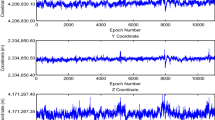Abstract
Classical outlier detection test methods such as Baarda test and Pope test are generally preferred in geodetic problems. They depend on the Least Square Estimation (LSE) and LSE is very sensitive to the variations of the model. The capacity of the LSE changes depending on the different significance level, different type of outlier, the number of outlier, magnitude of outlier, number of observations and the number of unknowns. In statistics, the power of test is the probability of rejecting the null hypothesis when the null hypothesis is false. It is a theoretical assumption and depends on the significance level α (Type I error) and β (Type II error). The different types of the outliers, such as random or non-random, affect the results of the test methods; but the power of test is the same for all different types of the outliers. In this study, empirical estimation of the power of test is presented as Mean Success Rate (MSR). The theoretical power of test and empirical MSR have been estimated for univariate model and linear model by using Baarda test; according to the obtained results, MSR can be used as empirical value of the power of test and capacity of the test models. Also, MSR reflects more realistic results than the theoretical power of test.
Similar content being viewed by others
References
Atkinson A.C., 1985. Plots, Transformations and Regression. Oxford University Press, Oxford, U.K.
Aydin C., 2012. Power of global test in deformation analysis. J. Surv. Eng., 138, 51–56.
Baarda W., 1967. Statistical concepts in geodesy. Publication on Geodesy, New Series, 2(4), Netherlands Geodetic Commission, Delft, The Netherlands.
Baarda W., 1968. A testing procedure for use in geodetic Networks. Publication on Geodesy, New Series, 2(5), Netherlands Geodetic Commission, Delft, The Netherlands.
Chen Y.Q., Kavouras M. and Chrzanowski A., 1987. A strategy for detection of outlying observations in measurements of high precision. The Canadian Surveyor, 41, 529–540.
Cook R.D. and Weisberg S., 1982. Residuals and Influence in Regression. Chapman & Hall, New York.
Donoho D.L. and Huber P.J., 1983. The notion of breakdown point. In: Bickel P.J., Doksum K. and Hodges J.L. Jr. (Eds), A Festschrift for Erich Lehmann. Wadsworth, Belmont, CA, 157–184.
Hadi A.S. and Simonoff J.S., 1993. Procedures for the identification of multiple outliers in linear models. J. Am. Stat. Assoc., 88, 1264–1272.
Hampel F., Ronchetti E., Rousseeuw P. and Stahel W., 1986. Robust Statistics: the Approach Based on Influence Functions. John Wiley and Sons, New York.
Heck B., 1981. Der Einfluss einzelner Beobachtungen auf das Ergebnis einer und die Suche nach Ausreissern in den beobachtungen. Allg. Verm. Nachricht., 88, 17–34.
Hekimoglu S., 1997. The finite sample breakdown points of the conventional iterative outlier detection procedures. J. Surv. Eng., 123, 15–31.
Hekimoglu S. and Koch K.R., 1999. How can reliability of the robust methods be measured? In: Altan M.O. and Gründige L. (Eds), Third Turkish-German Joint Geodetic Days, Volume 1. Istanbul Technical University, Istanbul, Turkey, 179–196.
Hekimoglu S. and Koch K.R., 2000. How can reliability of the test for outliers be measured? Allg. Verm. Nachricht., 107, 247–254.
Hekimoglu S., Erdogan B., Erenoglu R.C. and Hosbas R.G., 2011. Increasing the efficacy of the tests for outliers for geodetic networks. Acta Geod. Geophys. Hung., 46, 291–308.
Hekimoglu S. and Erdogan B., 2012. New median approach to define configuration weakness of deformation networks. J. Surv. Eng., 138, 101–108.
Huber P.J., 1981. Robust Statistics. John Wiley and Sons., New York.
Knight N.L., Wang J. and Rizos C., 2010. Generalised measures of reliability for multiple outliers. J. Geodesy, 84, 625–635.
Koch K.R., 1999. Parameter Estimation and Hypothesis Ttesting in Linear Models, 2nd Edition. Springer-Verlag, Berlin, Germany.
Koch K.R., 2013a. Robust estimation by expectation maximization algorithm. J. Geodesy, 87, 107–116.
Koch K.R., 2013b. Comparison of two robust estimations by expectation maximization algorithms with Huber’s method and outlier tests. J. Appl. Geodesy, 7, 115–123.
Kok J.J., 1984. On Data Snooping and Multiple Outlier Testing. NOAA Technical Report, 30. U.S. Department of Commerce, Rockville, MD.
Kuang S., 1991. Optimization and Design of Deformation Monitoring Schemes. Ph.D. Thesis. Report 157. Department of Surveying Engineering, University of New Brunswick, Fredericton, NB, Canada.
Lehmann R., 2010. Normierte Verbeßserungen-wie groß ist zu groß? Allgemeine Vermessungsnachrichten, 2, 53–61 (in German.
Lehmann R., 2012a. Geodätische Fehlerrechnung mit der skalenkontaminierten Normalverteilung. Allgemeine Vermessungsnachrichten, 143–149 (in German).
Lehmann R., 2012b. Improved critical values for extreme normalized and studentized residuals in Gauss-Markov models. J. Geodesy, 86, 1137–1146.
Maronna R., Martin D. and Yohai V., 2006. Robust Statistics. John Wiley and Sons., New York.
Neyman J. and Pearson E.S., 1933. On the problem of the most efficient tests of statistical hypotheses. Philos. Trans. R. Soc. Lond. Ser. A-Math. Phys. Eng. Sci., 231, 289–337.
Pope A.J., 1976. The Statistics of Residuals and the Outlier Detection of Outliers. NOAA Technical Report, 65. U.S. Department of Commerce, Rockville, MD.
Teunissen P.J.G., 2000. Testing Theory-an Introduction. Delft University, Delft, The Netherlands.
Teunissen P.J.G., 2018. Distributional theory for the DIA method. J. Geodesy, 92, 59–80.
Wang J. and Chen Y.Q., 1999. Outlier detection and reliability measures for singular adjustment models. Geomat. Res. Australasia, 71, 57–72.
Wang J. and Knight N.L., 2012. New outlier separability test and its application in GNSS positioning. J. Glob. Posit. Syst., 11, 46–57.
Yang L., Wang J., Knight N.L. and Shen Y., 2013. Outlier separability analysis with a multiple alternative hypotheses test. J. Geodesy, 87, 591–604.
Zaminpardaz S. and Teunissen P.J.G., 2018. DIA-datasnooping and identifiability. J. Geodesy, DOI: https://doi.org/10.1007/s00190-018-1141-3(in print).
Author information
Authors and Affiliations
Corresponding author
Rights and permissions
About this article
Cite this article
Erdogan, B., Hekimoglu, S., Durdag, U.M. et al. Empirical estimation of the power of test in outlier detection problem. Stud Geophys Geod 63, 55–70 (2019). https://doi.org/10.1007/s11200-018-1144-9
Received:
Revised:
Accepted:
Published:
Issue Date:
DOI: https://doi.org/10.1007/s11200-018-1144-9




